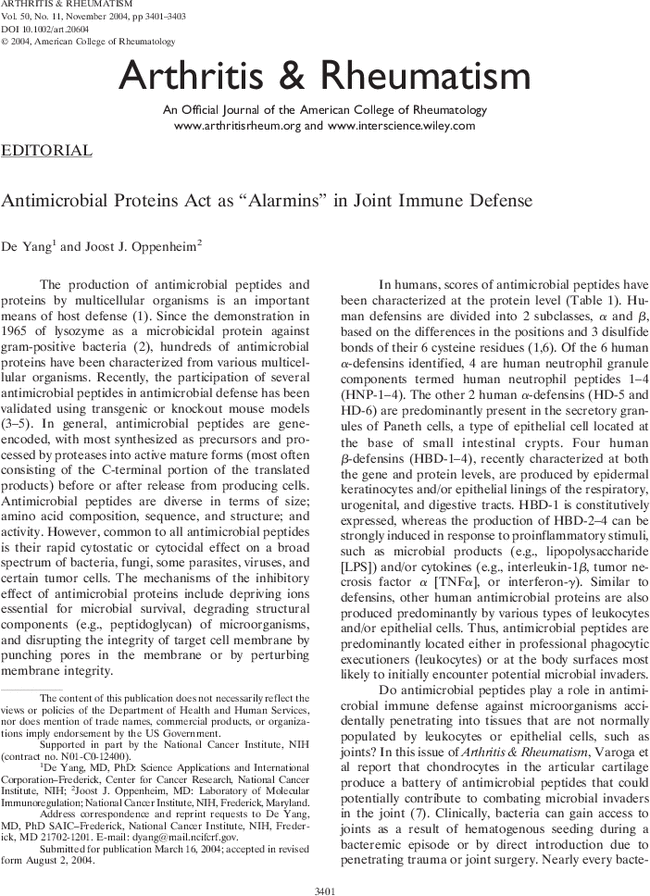Antimicrobial proteins act as “alarmins” in joint immune defense†
Corresponding Author
De Yang
Science Applications and International Corporation–Frederick, Center for Cancer Research, National Cancer Institute, NIH, Frederick, Maryland
SAIC–Frederick, National Cancer Institute, NIH, Frederick, MD 21702-1201Search for more papers by this authorJoost J. Oppenheim
Laboratory of Molecular Immunoregulation; National Cancer Institute, NIH, Frederick, Maryland
Search for more papers by this authorCorresponding Author
De Yang
Science Applications and International Corporation–Frederick, Center for Cancer Research, National Cancer Institute, NIH, Frederick, Maryland
SAIC–Frederick, National Cancer Institute, NIH, Frederick, MD 21702-1201Search for more papers by this authorJoost J. Oppenheim
Laboratory of Molecular Immunoregulation; National Cancer Institute, NIH, Frederick, Maryland
Search for more papers by this authorThe content of this publication does not necessarily reflect the views or policies of the Department of Health and Human Services, nor does mention of trade names, commercial products, or organizations imply endorsement by the US Government.

REFERENCES
- 1 Zasloff M. Antimicrobial peptides of multicellular organisms. Nature 2002; 415: 389–95.
- 2 Glynn AA, Milne CM. Lysozyme and immune bacteriolysis. Nature 1965; 207: 1309–10.
- 3 Nizet V, Ohtake T, Lauth X, Trowbridge J, Rudisill J, Dorschner RA, et al. Innate antimicrobial peptide protects the skin from invasive bacterial infection. Nature 2001; 414: 454–7.
- 4 Wilson CL, Ouellette AJ, Satchell DP, Ayabe T, Lopez-Boado YS, Stratman JL, et al. Regulation of intestinal α-defensin activation by the metalloproteinase matrilysin in innate host defense. Science 1999; 286: 113–7.
- 5 Salzman NH, Ghosh D, Huttner KM, Paterson Y, Bevins CL. Protection against enteric salmonellosis in transgenic mice expressing a human intestinal defensin. Nature 2003; 422: 522–6.
- 6 Ganz T. Defensins: antimicrobial peptides of innate immunity. Nat Rev Immunol 2003; 3: 710–20.
- 7 Varoga D, Pufe T, Harder J, Meyer-Hoffert U, Mentlein R, Schroder JM, et al. Production of endogenous antibiotics in articular cartilage. Arthritis Rheum 2004; 50: 3526–34.
- 8 Shirtliff ME, Mader JT. Acute septic arthritis. Clin Microbiol Rev 2002; 15: 527–44.
- 9 Paulsen F, Pufe T, Conradi L, Varoga D, Tsokos M, Papendieck J, et al. Antimicrobial peptides are expressed and produced in healthy and inflamed human synovial membranes. J Pathol 2002; 198: 369–77.
- 10 Peschel A, Otto M, Jack RW, Kalbacher H, Jung G, Gotz F. Inactivation of the dlt operon in Staphylococcus aureus confers sensitivity to defensins, protegrins, and other antimicrobial peptides. J Biol Chem 1999; 274: 8405–10.
- 11 Jin T, Bokarewa M, Foster T, Mitchell J, Higgins J, Tarkowski A. Staphylococcus aureus resists human defensins by production of staphylokinase, a novel bacterial evasion mechanism. J Immunol 2004; 172: 1169–76.
- 12 Yang D, Biragyn A, Hoover DM, Lubkowski J, Oppenheim JJ. Multiple roles of antimicrobial defensins, cathelicidins, and eosinophil-derived neurotoxin in host defense. Annu Rev Immunol 2004; 22: 181–215.
- 13 Lillard JW Jr, Boyaka PN, Chertov O, Oppenheim JJ, McGhee JR. Mechanisms for induction of acquired host immunity by neutrophil peptide defensins. Proc Natl Acad Sci U S A 1999; 96: 651–6.
- 14 Biragyn A, Surenhu M, Yang D, Ruffini PA, Haines BA, Klyushnenkova E, et al. Mediators of innate immunity that target immature, but not mature, dendritic cells induce antitumor immunity when genetically fused with nonimmunogenic tumor antigens. J Immunol 2001; 167: 6644–53.
- 15 Brogden KA, Heidari M, Sacco RE, Palmquist D, Guthmiller JM, Johnson GK, et al. Defensin-induced adaptive immunity in mice and its potential in preventing periodontal disease. Oral Microbiol Immunol 2003; 18: 95–9.




